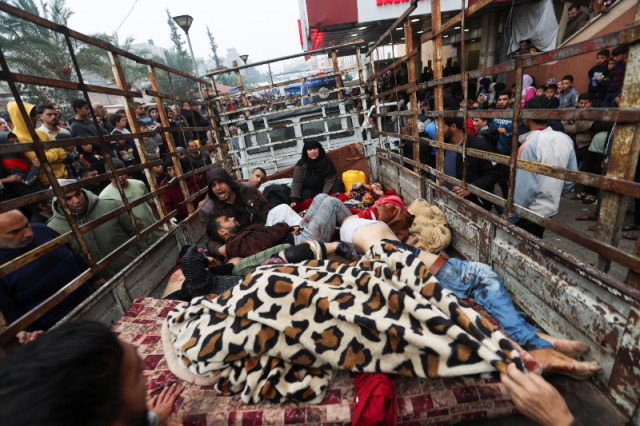
- Israeli forces kill one man in West Bank
- Israel says three of its soldiers killed in Gaza fighting on Monday
- Israel is considering flooding Gaza tunnels with seawater to drive out Hamas fighters – WSJ
GAZA — Israeli forces pressed ahead with their air and ground bombardment of southern Gaza Strip, killing and wounding dozens of Palestinians, even as the United States and the United Nations repeatedly urged them to protect civilians.
Asked on Monday about the mounting death toll since a truce collapsed between Israel and Hamas on Friday, Israel’s closest ally the United States said it was too soon to say whether Israel was doing enough to protect civilians and that it expected Israel not to strike zones it has identified as safe.
Residents and journalists on the ground said the intense Israeli air strikes in the south of the densely populated coastal enclave included areas where Israel had told people to seek shelter.
At the United Nations, Secretary-General Antonio Guterres appealed to Israel to avoid further action that would make the already dire humanitarian situation in Hamas-run Gaza worse, and to spare civilians from more suffering.
“The Secretary-General is extremely alarmed by the resumption of hostilities between Israel and Hamas… For people ordered to evacuate, there is nowhere safe to go and very little to survive on,” U.N. spokesperson Stephane Dujarric said.
Israel largely captured the northern half of Gaza in November, and since a week-long truce collapsed on Friday they have swiftly pushed deep into the southern half.
Hamas ally Islamic Jihad’s armed wing said its fighters engaged in fierce clashes with Israeli soldiers north and east of Khan Younis, Gaza’s main southern city.
Israeli tanks have driven into Gaza across the border and cut off the main north-south route, residents said. The Israeli military said the central road out of Khan Younis to the north “constitutes a battlefield” and was now shut.
Israel on Tuesday said three of its soldiers had died in combat in Gaza on Monday, in what Army Radio described as a day of fierce battles with Hamas fighters. Seventy-eight soldiers have died in Gaza since the start of the military’s ground invasion.
Israel launched its assault to wipe out Hamas in retaliation for an Oct. 7 cross-border attack by Hamas gunmen on border towns, kibbutzim and a music festival. The militants killed 1,200 people and seized 240 hostages, according to Israeli tallies – the deadliest single day in Israel’s 75-year history.
In eight weeks of warfare, the Gazan health ministry said at least 15,899 Palestinians, 70% of them women or under 18s, have been killed.
Philippe Lazzarini, who heads the UN agency for Palestinian refugees in Gaza (UNRWA), said the resumption of Israel’s military operation was repeating “horrors from past weeks” by displacing people who had been previously displaced, overcrowding hospitals and further strangling the humanitarian operation due to limited supplies.
“We have said it repeatedly. We are saying it again. No place is safe in Gaza, whether in the south, or the southwest, whether in Rafah or in any unilaterally so-called ‘safe zone’,” he said.
The Director General of the World Health Organisation (WHO), Tedros Adhanom Ghebreyesus, reiterated calls for Israel to protect civilians and civilian infrastructure including hospitals.
“WHO received notification from the Israel Defense Forces that we should remove our supplies from our medical warehouse in southern Gaza within 24 hours, as ground operations will put it beyond use,” he posted on X, formerly known as Twitter, on Monday.
Displaced in overcrowded enclave
As many as 80% of Gaza’s 2.3 million people have already fled their homes in the eight weeks of war that has wrought devastation across the overcrowded enclave.
On Monday, Israel ordered Palestinians to leave parts of Khan Younis, indicating they should move towards the Mediterranean coast and towards Rafah, a town near the Egyptian border.
Desperate Gazans in Khan Younis packed their belongings and headed towards Rafah. Most were on foot, walking past ruined buildings in a solemn and silent procession.
In Washington, a State Department spokesperson said it was an “improvement” that Israel was seeking evacuations in targeted areas as opposed to entire cities.
U.S. National Security Advisor Jake Sullivan said Washington expected Israel to avoid attacking areas identified as “no-strike” zones in Gaza.
He said the U.S. had discussed with Israel how long the war with Hamas should continue, but he declined to share that timeline.
A senior Israeli official said it was taking the time to order more precise evacuations in order to limit civilian casualties, but that Israel could not rule them out altogether.
“We did not start this war. We regret civilian casualties but when you want to face evil, you have to operate,” the official said.
Over 100 of the hostages seized by Iran-backed Hamas were freed during a seven-day truce last month. Israeli authorities say seven civilians and an army colonel died in captivity, while 137 hostages remain in Gaza.
The Gazan health ministry says about 900 Palestinians have been killed since the truce ended on Friday.
Israel accuses Hamas of putting civilians in danger by operating from civilian areas, including in tunnels which can only be destroyed by large bombs. Hamas denies it does so.
The Wall Street Journal reported on Monday, citing U.S. officials, that Israel had assembled a system of pumps that could be used to flood Hamas tunnels.
It was not clear whether Israel would consider using the pumps before all hostages were released, according to the story.
In the West Bank, Israeli forces killed one Palestinian man and critically wounded another person in different areas on Tuesday, the Ramallah-based health ministry said.
– Reporting by Mohammed Salem in Gaza, Maayan Lubell, Ari Rabinovich and Emily Rose in Jerusalem, Maggie Fick in Beirut, and Andrew Mills in Doha; Writing by Humeyra Pamuk and Stephen Coates; Editing by Lincoln Feast and Kim Coghill









